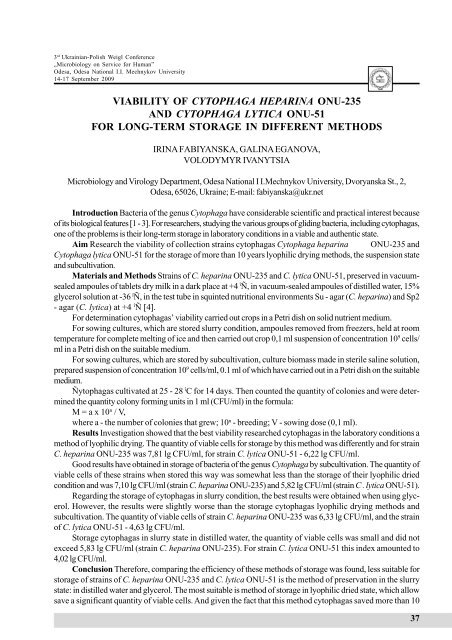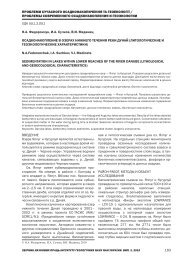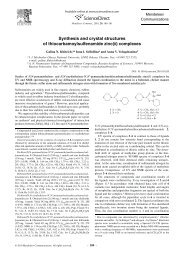viability of cytophaga heparina onu-235 and cytophaga lytica onu ...
viability of cytophaga heparina onu-235 and cytophaga lytica onu ...
viability of cytophaga heparina onu-235 and cytophaga lytica onu ...
Create successful ePaper yourself
Turn your PDF publications into a flip-book with our unique Google optimized e-Paper software.
3 rd Ukrainian-Polish Weigl Conference<br />
„Microbiology on Service for Human”<br />
Odesa, Odesa National I.I. Mechnykov University<br />
14-17 September 2009<br />
VIABILITY OF CYTOPHAGA HEPARINA ONU-<strong>235</strong><br />
AND CYTOPHAGA LYTICA ONU-51<br />
FOR LONG-TERM STORAGE IN DIFFERENT METHODS<br />
IRINA FABIYANSKA, GALINA EGANOVA,<br />
VOLODYMYR IVANYTSIA<br />
Microbiology <strong>and</strong> Virology Department, Odesa National I I.Mechnykov University, Dvoryanska St., 2,<br />
Odesa, 65026, Ukraine; E-mail: fabiyanska@ukr.net<br />
Introduction Bacteria <strong>of</strong> the genus Cytophaga have considerable scientific <strong>and</strong> practical interest because<br />
<strong>of</strong> its biological features [1 - 3]. For researchers, studying the various groups <strong>of</strong> gliding bacteria, including <strong>cytophaga</strong>s,<br />
one <strong>of</strong> the problems is their long-term storage in laboratory conditions in a viable <strong>and</strong> authentic state.<br />
Aim Research the <strong>viability</strong> <strong>of</strong> collection strains <strong>cytophaga</strong>s Cytophaga <strong>heparina</strong> ONU-<strong>235</strong> <strong>and</strong><br />
Cytophaga <strong>lytica</strong> ONU-51 for the storage <strong>of</strong> more than 10 years lyophilic drying methods, the suspension state<br />
<strong>and</strong> subcultivation.<br />
Materials <strong>and</strong> Methods Strains <strong>of</strong> C. <strong>heparina</strong> ONU-<strong>235</strong> <strong>and</strong> C. <strong>lytica</strong> ONU-51, preserved in vacuumsealed<br />
ampoules <strong>of</strong> tablets dry milk in a dark place at +4 î Ñ, in vacuum-sealed ampoules <strong>of</strong> distilled water, 15%<br />
glycerol solution at -36 î Ñ, in the test tube in squinted nutritional environments Su - agar (C. <strong>heparina</strong>) <strong>and</strong> Sp2<br />
- agar (C. <strong>lytica</strong>) at +4 î Ñ [4].<br />
For determination <strong>cytophaga</strong>s’ <strong>viability</strong> carried out crops in a Petri dish on solid nutrient medium.<br />
For sowing cultures, which are stored slurry condition, ampoules removed from freezers, held at room<br />
temperature for complete melting <strong>of</strong> ice <strong>and</strong> then carried out crop 0,1 ml suspension <strong>of</strong> concentration 10 9 cells/<br />
ml in a Petri dish on the suitable medium.<br />
For sowing cultures, which are stored by subcultivation, culture biomass made in sterile saline solution,<br />
prepared suspension <strong>of</strong> concentration 10 9 cells/ml, 0.1 ml <strong>of</strong> which have carried out in a Petri dish on the suitable<br />
medium.<br />
Ñytophagas cultivated at 25 - 28 î C for 14 days. Then counted the quantity <strong>of</strong> colonies <strong>and</strong> were determined<br />
the quantity colony forming units in 1 ml (CFU/ml) in the formula:<br />
M = a x 10 n / V,<br />
where a - the number <strong>of</strong> colonies that grew; 10 n - breeding; V - sowing dose (0,1 ml).<br />
Results Investigation showed that the best <strong>viability</strong> researched <strong>cytophaga</strong>s in the laboratory conditions a<br />
method <strong>of</strong> lyophilic drying. The quantity <strong>of</strong> viable cells for storage by this method was differently <strong>and</strong> for strain<br />
C. <strong>heparina</strong> ONU-<strong>235</strong> was 7,81 lg CFU/ml, for strain C. <strong>lytica</strong> ONU-51 - 6,22 lg CFU/ml.<br />
Good results have obtained in storage <strong>of</strong> bacteria <strong>of</strong> the genus Cytophaga by subcultivation. The quantity <strong>of</strong><br />
viable cells <strong>of</strong> these strains when stored this way was somewhat less than the storage <strong>of</strong> their lyophilic dried<br />
condition <strong>and</strong> was 7,10 lg CFU/ml (strain C. <strong>heparina</strong> ONU-<strong>235</strong>) <strong>and</strong> 5,82 lg CFU/ml (strain C . <strong>lytica</strong> ONU-51).<br />
Regarding the storage <strong>of</strong> <strong>cytophaga</strong>s in slurry condition, the best results were obtained when using glycerol.<br />
However, the results were slightly worse than the storage <strong>cytophaga</strong>s lyophilic drying methods <strong>and</strong><br />
subcultivation. The quantity <strong>of</strong> viable cells <strong>of</strong> strain C. <strong>heparina</strong> ONU-<strong>235</strong> was 6,33 lg CFU/ml, <strong>and</strong> the strain<br />
<strong>of</strong> C. <strong>lytica</strong> ONU-51 - 4,63 lg CFU/ml.<br />
Storage <strong>cytophaga</strong>s in slurry state in distilled water, the quantity <strong>of</strong> viable cells was small <strong>and</strong> did not<br />
exceed 5,83 lg CFU/ml (strain C. <strong>heparina</strong> ONU-<strong>235</strong>). For strain C. <strong>lytica</strong> ONU-51 this index amounted to<br />
4,02 lg CFU/ml.<br />
Conclusion Therefore, comparing the efficiency <strong>of</strong> these methods <strong>of</strong> storage was found, less suitable for<br />
storage <strong>of</strong> strains <strong>of</strong> C. <strong>heparina</strong> ONU-<strong>235</strong> <strong>and</strong> C. <strong>lytica</strong> ONU-51 is the method <strong>of</strong> preservation in the slurry<br />
state: in distilled water <strong>and</strong> glycerol. The most suitable is method <strong>of</strong> storage in lyophilic dried state, which allow<br />
save a significant quantity <strong>of</strong> viable cells. And given the fact that this method <strong>cytophaga</strong>s saved more than 10<br />
37
years, the results suggest high efficiency <strong>and</strong> expediency <strong>of</strong> its use for long-term storage <strong>of</strong> bacteria <strong>of</strong> this<br />
group.<br />
References<br />
1. Agarwal S., Hunnicutt D. W., McBride M. J. Cloning <strong>and</strong> characterization <strong>of</strong> the<br />
Flavobacterium johnsoniae (Cytophaga johnsoniae) gliding motility gene, gldA // Appl. Environ.<br />
Microbiol. – 2008. – Vol. 121 (12). – P. 1134 – 1142.<br />
2. McBride M. J., Braun T. F. GldI is a lipoprotein that is required for Flavobacterium<br />
johnsoniae gliding motility <strong>and</strong> chitin utilization // J. Bacteriol. – 2004. – Vol. 186. – P. 2295 –<br />
2302.<br />
3. McKay A.M. Cell-associated amylase activity in Cytophaga johnsonae // Microbiol. Res.<br />
– 2007. - Vol. 145. – P. 765 – 778.<br />
4. Êàòàëîã êóëüòóð Óêðà¿íñüêî¿ Êîëåêö³¿ ̳êðîîðãàí³çì³â (ÓÊÌ). – Ê., 1998. – 413 ñ.<br />
38
















